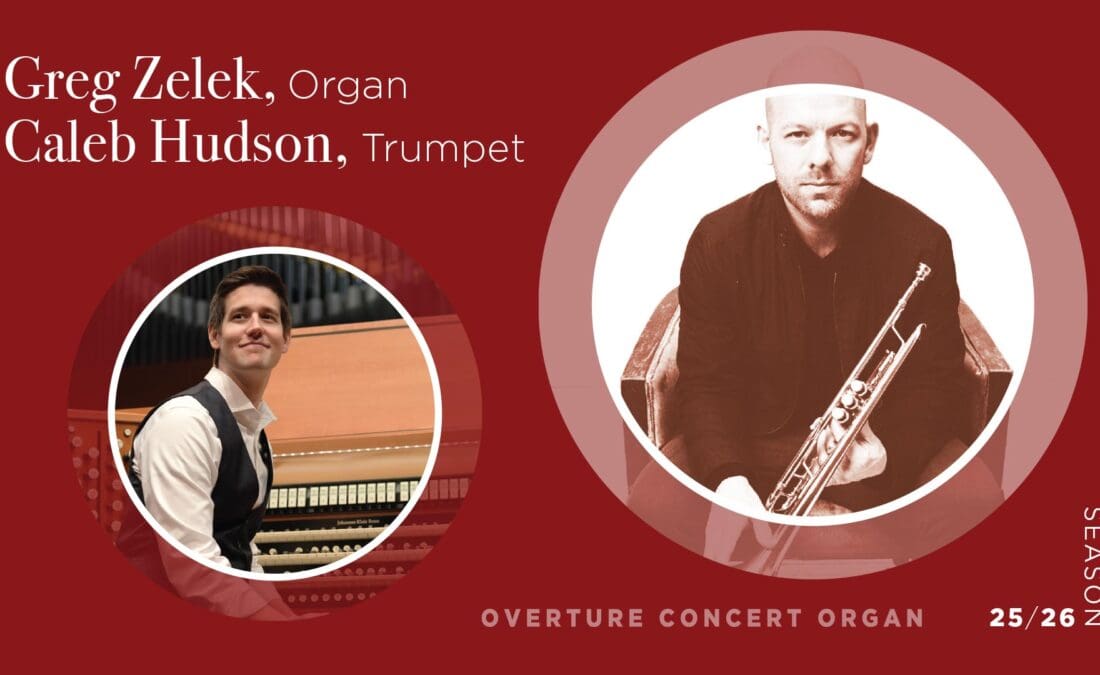We invite you to read through Michael Allsen’s program notes for the November 18th Organ Concert Series No. 2.
Program Notes
Our second organ series program pairs Greg Zelek and the Overture Concert Organ with trumpeter Caleb Hudson. Mr. Hudson is a member of the acclaimed Canadian Brass, and teaches at the University of Texas at Austin. As always, this is a wide-ranging program, including classic works for solo organ, new pieces written for and by our soloist, a little bit of jazz, and a imaginary Bach trumpet concerto!
 Giovanni Battista Martini (1706-1784)
Giovanni Battista Martini (1706-1784)
Toccata in D Major for Trumpet and Organ (arr. Michael Rondeau)
Giovanni Battista Martini, an organist, composer, writer, musical antiquarian, and teacher, was among the most learned musicians of 18th-century Italy. Padre Martini, who took vows as a Franciscan when he a teenager, was clearly a beloved figure in his native Bologna, and he was admired by musicians all across Europe for his erudition and teaching. In the summer of 1770, a 14-year-old Mozart spent several weeks studying counterpoint with Martini, whose abilities and personality Mozart continued to praise for the rest of his life, writing years later about him that “I never cease to grieve that I am far away from that one person in the world whom I love, revere and esteem most of all.” Martini wrote one of the first comprehensive histories of music, and also published influential collection of counterpoint examples. As a composer, Martini wrote primarily sacred vocal works, but also several symphonies and sinfonias, and over 100 works for organ. This brilliant version of one of Martini’s organ Toccatas was popularized in 1960 in a recording by legendary French trumpeter, Maurice André. The arrangement played here is by Canadian trumpeter Michael Rondeau.
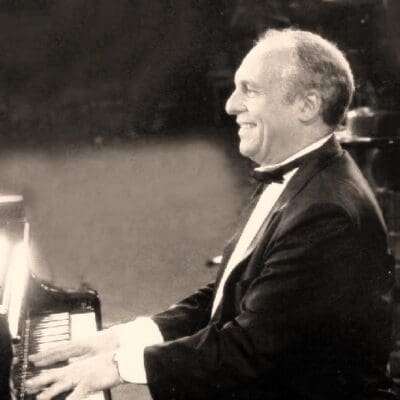 Claude Bolling (1930-2020)
Claude Bolling (1930-2020)
Rag-Polka from Toot Suite
Claude Bolling, sometimes known as the “French Gershwin,” had a long and successful career in his native France. Bolling was a renowned jazz pianist and bandleader and also wrote scores for over 100 films. However, his greatest international success was a series of popular “crossover” recordings in which he blended jazz and classical styles. These began in 1975, with the Suite for Flute and Jazz Piano—a collaboration between Bolling and the great French flutist Jean-Pierre Rampal. Bolling went on to collaborate and record with several other Classical artists in succeeding years. Including the Toot Suite (1980), written originally for trumpeter Maurice André and Bolling’s jazz trio. It was not only a true virtuoso display for André—the trumpet plays nearly every measure of this demanding 20-minute piece—but it is also a technical challenge: it calls for five different trumpets in the course of six movements. The B-flat cornet lends a distinctly old-fashioned “concert in the park” sound to the third movement, Rag-Polka. Here, the cornet weaves its way through increasingly flashy variations on the syncopated main theme and a sinuous, chromatic countertheme… and the organist gets to play some flashy bits of his own!
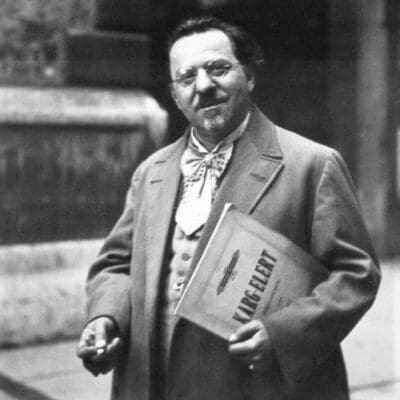 Sigfrid Karg-Elert (1877-1933)
Sigfrid Karg-Elert (1877-1933)
Marche triomphale “Nun danket alle Gott”
Born the youngest of twelve children, in a small city in Germany’s Black Forest, the precocious Sigfrid Karg-Elert was fortunate when his family moved to Leipzig when he was age 5. The young boy studied piano and organ, eventually came to the attention of composer Emil von Reznicek, who arranged a scholarship that allowed Karg-Elert to study at the Leipzig Conservatory, where he would eventually teach music theory and composition. By the time he died, after an extended illness, Karg-Elert’s music was little regarded, even in his native Germany. His best-known piece—the Marche triomphale “Nun danket alle Gott”—refers to a 17th-century Lutheran chorale tune (familiar in English as Now Thank We All Our God). However, he treats the melody very freely in this bravura 5-minute work—you’ll often be hard-pressed to find the hymn tune, even if you’ve sung it many times! The first six pitches are there in the opening fanfare, and other fragments show up as well. But overall, this is a grand and joyful showpiece for the solo organ.
 Remy Le Bouef (b. 1986)
Remy Le Bouef (b. 1986)
Vignette No. 20
New York City-based saxophonist Remy LeBouef is one of the leading voices in jazz today. He has worked extensively as a band leader and sideman, collaborating with groups as diverse as Wynton Marsalis’s Jazz at Lincoln Center, Orchestra, HAIM, and Le Bouef Brothers (an experimental ensemble with his identical twin brother Pascal). Le Boeuf is an Assistant Professor and Director of Jazz and Commercial Music Studies at the University of Denver’s Lamont School of Music. He provides the following note on his Vignette No. 20:
When Caleb Hudson approached me to write something for his ensemble, I was in the midst of exploring a particular creative process involving writing short linear compositions on the saxophone that I call “vignettes.” While most are written for solo saxophone, Nos. 20 and 21 were written specifically for Caleb’s ensemble. I enjoyed starting with a linear concept and then expanding it to more voices, as if I were taking a Bach Cello Suite and expanding the implied voices within it to fit a chamber quintet. The pitch bends and pristine melodies of Vignette No. 20 showcase Caleb’s delicacy and his penchant for beauty.
Vignette No. 20 was recorded by Hudson on his 2025 album Nothing Less. It was scored for an ensemble of trumpet, flute, clarinet, violin, and cello, here adapted for organ. In the original version, the trumpet line blossoms forth from a haze of string harmonics. The background playing, always gentle, sometimes picks up the trumpet’s melody, and sometimes provides an inobtrusive accompaniment.
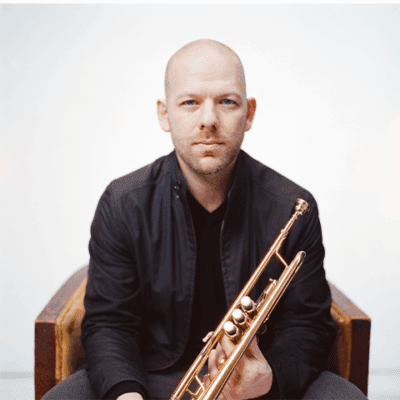 Caleb Hudson (b. 1988)
Caleb Hudson (b. 1988)
That They Will Know from Nothing Less
Hudson provides the following note on his Nothing Less:
Taking inspiration from the Old Testament story of Elijah, this composition of mine was recorded on the 2024 album of the same name. The four movements—Still Small Voice (divine whisper amidst despair), Prophets of Baal (frenetic dances of futility), That They Will Know (Elijah’s heartfelt plea), and Covenant (spiritual renewal and transformation)—each depicts a pivotal moment in Elijah’s story.
The accompaniment—originally for flute, bass clarinet, violin and cello—is here adapted for organ. That They Will Know begins with a strong, lyrical trumpet statement—Elijah himself—above a chattering accompaniment. The accompaniment eventually joins the trumpet in character, and the piece closes in a mood of quiet exaltation.
 Craig Sellar Lang (1891-1971)
Craig Sellar Lang (1891-1971)
Fanfare, Op. 85
Tuba Tune, Op. 15
Next is a set of three British works for solo organ, beginning with a brilliant Fanfare by Craig Sellar Lang. Born in New Zealand, Lang spent his entire career in England. He was trained at Clifton College in Bristol, London’s Royal College of Music, and the University of Durham. He later taught at Clifton College and Christ’s Hospital School in West Sussex. Lang is perhaps best known to organists as the author of several educational collections and training works, though he was an accomplished composer of sacred and concert works throughout his career. His bravura Fanfare is a relatively late work, from the 1950s.
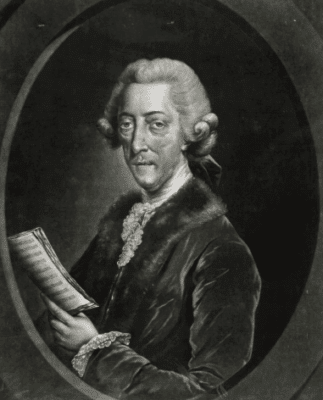
Thomas Arne (1710-1778)
Flute Solo
Thomas Arne was one of the finest theatrical composers of 18th-century Britain. Though George Frideric Handel and others ruled the lofty realms of Italian opera, Arne’s specialty was musical theater in English: masques, pantomimes, burlesques, odes, incidental music for dozens of stage plays, and later English-language operas and oratorios. He also had some success as a keyboard composer. His playful Flute Solo features a highly ornamented melody played on the Flute stop.
This set closes with Lang’s Tuba Tune, which he first published in 1929, and which remains one of his most popular works nearly a century later. He wrote this with the chapel organ of Christ’s Hospital School in mind: an instrument that reportedly had a remarkably resonant and powerful rank of Tuba pipes. The piece starts with a lively 12/8 tune in the highest manual. A slightly less active middle section contains some interesting harmonic twists, before a reprise of the opening music.
 Oskar Lindberg (1887-1955)
Oskar Lindberg (1887-1955)
Gammal fäbodpsalm från Dalarna
Swedish composer, organist, and teacher Oskar Lindberg trained at the Swedish national Academy of music, and taught harmony classes there for well over 30 years. He was probably most impactful as a church musician, however. In 1939, Lindberg published a new edition of the Church of Sweden’s hymnbook, including many of his own works. He was born in the rural village of Gagnef in the Dalarna region of Sweden, and remain connected to the folk music of Dalarna throughout his life, frequently channeling folk tunes that he had grown up with or collected in his compositions. His best-known piece, Gammal fäbodpsalm från Dalarna (Old Folk-hymn from Dalarna) comes from 1936, when Lindberg first heard this tune at a worship meeting in Gagnef. In the version played here, the trumpet plays the beautifully simple tune, and the organ plays Lindberg’s calm, impressionistic accompaniment.
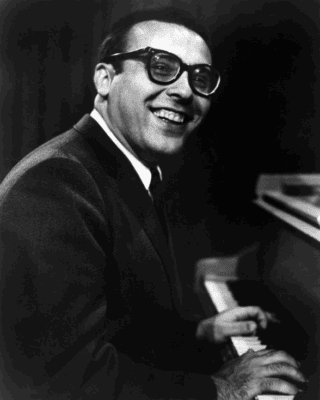 Vince Guaraldi (1928-1976)
Vince Guaraldi (1928-1976)
Thanksgiving Theme (arr. Greg Zelek)
Johann Sebastian Bach
Nun danket alle Gott from Cantata No. 79 (arr. Virgil Fox)
Given the season, it’s perfectly appropriate to include a couple of Thanksgiving-themed organ works on this program, Pianist and composer Vince Guaraldi was already a well-known jazz soloist and band leader in 1963, when producer Lee Mendelson approached him about writing a score for an upcoming documentary about the wildly successful Peanuts comic strip by Charles Schultz. Guaraldi responded with a tune called Linus and Lucy that he played to Mendlelson by phone. Guaraldi got the gig, and would write scores for twelve Peanuts television specials beginning in 1965 with A Charlie Brown Christmas. [Note: I distinctly remember watching this on my grandparents’ brand new color TV—at least as impressive to seven-year-old me as the special itself was!] Guaraldi’s scores lent an aspect of sophistication and coolness to the Peanuts gang. In 1973, he wrote a score for A Charlie Brown Thanksgiving, now including a jazz quintet with trumpet and trombone, and a much broader musical palette that included funk and fusion-style jazz. Guaraldi’s Thanksgiving Theme, which appears at several points in the story, is a fast, breezy improvisatory jazz waltz with backing from an electronic organ.
 Next is an arrangement by the American organist and showman Virgil Fox (1912-1980). Fox had a well-deserved reputation as an organ virtuoso and was the longtime organist at New York City’s Riverside Church. In the 1960s and 1970s Fox popularized the music of Bach in a series of “Heavy Organ” concerts, staged with groovy, psychedelic light shows. His version of Nun danket alle Gott, is based upon the fourth movement of Bach’s cantata Gott der Herr ist ist Sonn und Schild, BWV 79. This was written for an October 31, 1724 Reformation Festival Sunday at Thomaskirche in Leipzig. Unlike the Marche triomphale, there’s no problem hearing the chorale tune in this case, which is laid out in phrases interlaced with lively orchestral passages. (In fact, Bach may have intended for the congregation to join the chorus in singing the chorale.)
Next is an arrangement by the American organist and showman Virgil Fox (1912-1980). Fox had a well-deserved reputation as an organ virtuoso and was the longtime organist at New York City’s Riverside Church. In the 1960s and 1970s Fox popularized the music of Bach in a series of “Heavy Organ” concerts, staged with groovy, psychedelic light shows. His version of Nun danket alle Gott, is based upon the fourth movement of Bach’s cantata Gott der Herr ist ist Sonn und Schild, BWV 79. This was written for an October 31, 1724 Reformation Festival Sunday at Thomaskirche in Leipzig. Unlike the Marche triomphale, there’s no problem hearing the chorale tune in this case, which is laid out in phrases interlaced with lively orchestral passages. (In fact, Bach may have intended for the congregation to join the chorus in singing the chorale.)
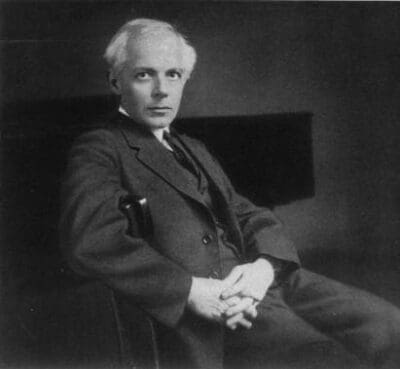 Béla Bartók (1881-1945)
Béla Bartók (1881-1945)
Romanian Folk Dances
Bartók spent much of his early career as a folksong collector, travelling the back roads of Romania, Transylvania, and his native Hungary with primitive recording equipment and music manuscript paper, often working with his friend and colleague Zoltan Kodály. Bartók and Kodály both published editions and books based on their research, and in both cases the music they collected had a profound influence on their own compositions. In the years before and during the first world war, Bartók published dozens of songs and piano pieces—the latter mostly intended for piano students—based on folk material. The concentrated little suite known as the Romanian Folk Dances was published in 1915 for piano, but he had collected most of the tunes upon which it was based in 1910 and 1912, during visits to Romanian communities living in Eastern Hungary. In the hyper-nationalistic period at the beginning of the Great War, Bartók and Kodály were actually drafted to continue their collecting as a patriotic duty, collecting songs from Hungarian soldiers. Bartók’s interests were broader, however and he continued to publish and arrange music from across eastern Europe, sometimes raising the ire of Hungarian nationalists. When he published the Romanian Folk Dances he was bitterly attacked by critics in Budapest for “abandoning the music of Hungary.” These sour notes aside, this set of vivacious musical miniatures remains one of Bartók’s most popular early works.
This is a suite of seven short dances: some of them lasting well under a minute. Jocul cu bata (Dance With Sticks) is a strident Transylvanian dance tune with strongly accented rhythms. Braul (Sash Dance) is a quirky dance begun by the accompaninent, and picked up by both players. Pe loc means “In one spot”—an intricate stamping dance done in place: here carried by solo trumpet above a mysterious drone, before coming to an inconclusive end. Buciumeana (Horn Dance) is a more lyrical Transylvanian melody that passes from the solo line to the organ. Poarga Romaneasca (Romanian Polka) is a vigorous tune that accompanies a traditional children’s game—a much more rhythmically intricate affair than the more familiar German and Polish polkas. This leads seamlessly into the final two dances, a pair of tiny movements titled Maruntel (Quick Dance). The music moves continually faster until a seemingly exhausted collapse.
program notes ©2025 by J. Michael Allsen
To view current and past program notes, please visit Michael Allsen’s website.

